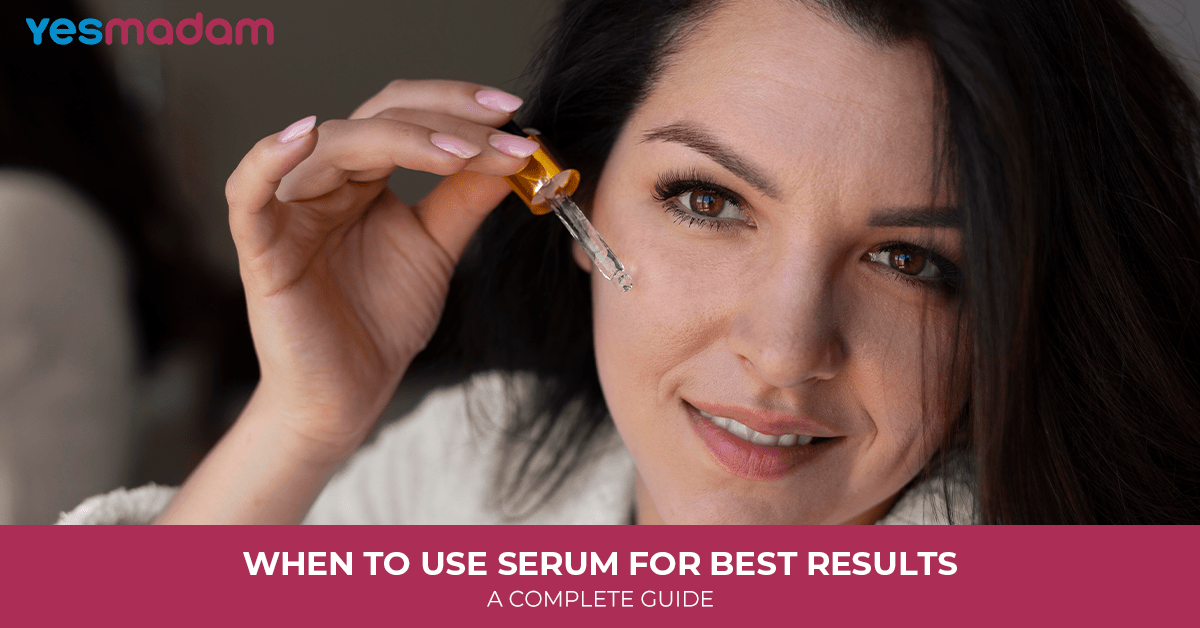
When to Use Serum for Best Results: A Complete Guide
If you’ve ever stood in front of your mirror wondering when to use serum for best results, you’re not alone. Serums are one of the most powerful products in skincare because they’re packed with concentrated active ingredients. But to truly see their magic, timing and technique matter just as much as the formula itself. Using a serum at the wrong time or layering it incorrectly can reduce its effectiveness—or worse, cause irritation.
In this guide, we’ll break down the best time to apply face serum, how to layer it with moisturizer, and the specific timing for different types of serums like Vitamin C and retinol. You’ll also learn about common mistakes people make when using serums and how to avoid them, ensuring your skin gets the maximum benefits.
Table of Contents
Why Serums Deserve a Spot in Your Skincare Routine
Serums are lightweight formulations designed to deliver high concentrations of active ingredients deep into your skin. Unlike moisturizers, which focus on hydration and barrier protection, serums target specific skin concerns like pigmentation, wrinkles, dullness, or acne.
Think of them as a “treatment step” in your routine. Because they’re potent, the timing of application plays a big role in how well they work.
More Information For You: Sunscreen vs Sunblock
Best Time to Apply Face Serum? Morning or Night

The best time to apply face serum depends on the type of serum and your skincare goals. For instance:
- Morning serums (like Vitamin C) are excellent for protecting against environmental stressors such as pollution and UV damage.
- Night serums (like retinol or peptides) help with repair and regeneration while your skin is in its natural healing mode during sleep.
General Rule of Thumb
Apply your serum after cleansing and toning but before moisturizing. This ensures the active ingredients penetrate effectively, instead of being blocked by heavier creams.
Serum Before or After Moisturizer?
This is one of the most common skincare questions. The answer is straightforward: always apply serum before moisturizer.
Here’s why:
- Serums are water-based and formulated with small molecules designed to sink into the skin quickly.
- Moisturizers are thicker and act as a seal, locking in hydration and nutrients.
If you reverse the order, the moisturizer creates a barrier that prevents the serum from absorbing properly, reducing its effectiveness.
Vitamin C Serum: When to Use
Vitamin C serum has become a cult favorite because of its brightening and antioxidant properties. But timing matters.
- Best Time: Morning, right after cleansing and before sunscreen.
- Why: Vitamin C helps neutralize free radicals from UV rays and pollution, boosting your sunscreen’s effectiveness and protecting skin throughout the day.
Tip: Always follow Vitamin C serum with sunscreen. Without SPF, you miss out on its protective benefits.
Retinol Serum: Morning or Night?
Retinol, often called the gold standard of anti-aging, works wonders on fine lines, acne, and uneven texture. But it’s highly sensitive to sunlight.
- Best Time: Night.
- Why: UV exposure can deactivate retinol and increase irritation. Your skin also repairs itself during sleep, making nighttime the ideal window for retinol to work its magic.
Tip: If you’re new to retinol, start with 2–3 times a week and gradually increase frequency as your skin builds tolerance.
How Often Should You Use Serum?
There’s no one-size-fits-all answer here—it depends on the type of serum and your skin’s needs.
- Daily use serums: Hydrating formulas with hyaluronic acid, niacinamide, or peptides can be used twice a day.
- Targeted serums: Exfoliating serums (like AHA/BHA) or retinol should be used less frequently, typically 2–4 times a week, depending on skin tolerance.
- Brightening serums: Vitamin C is generally safe for daily use in the morning.
Listen to your skin. If you notice irritation, scale back the frequency.
When to Apply Serum for Glowing Skin
If your main goal is a radiant, healthy glow, consistency is key. The best time to apply serum for glowing skin is morning and night, using serums suited to each time:
- Morning: Brightening serum like Vitamin C to give you a fresh, luminous start.
- Night: Hydrating or repairing serums (like hyaluronic acid or retinol) to work while your skin regenerates.
Layering the right serums at the right times ensures round-the-clock benefits.
Don’t Miss: How to Use Green Tea for Skin Whitening
Common Mistakes to Avoid When Using Serums

Even with the best products, simple mistakes can sabotage your results. Here are some to avoid:
- Using too much product: A few drops are enough. Over-applying doesn’t improve results and can cause waste or irritation.
- Mixing incompatible ingredients: For example, avoid using Vitamin C and retinol at the same time, as they can irritate skin.
- Skipping sunscreen: Active serums like Vitamin C and retinol increase sensitivity to the sun, making SPF non-negotiable.
- Not applying on damp skin: Applying hydrating serums like hyaluronic acid to damp skin maximizes absorption.
- Impatience: Serums need consistent use over weeks to show results. Expecting overnight miracles leads to disappointment.
Conclusion
Knowing when to use serum for best results is the difference between “meh” skincare and truly transformative outcomes. Apply Vitamin C in the morning, retinol at night, and always layer serums before moisturizer. Consistency, correct layering, and avoiding common mistakes will unlock the full potential of your serums—leading to radiant, healthier, and glowing skin.
FAQs
1. What is the best time to apply face serum?
The best time depends on the type of serum. Vitamin C is best in the morning for protection, while retinol should only be used at night. Hydrating serums like hyaluronic acid can be applied both morning and evening.
2. Should I use serum before or after moisturizer?
Always use serum before moisturizer. Serums need to penetrate the skin, while moisturizers sit on top to lock in hydration and nutrients. Reversing the order reduces serum effectiveness.
3. Can I use Vitamin C serum at night instead of morning?
Yes, you can, but it’s most beneficial in the morning because it fights free radicals from UV and pollution. If you use it at night, you’ll still see brightening benefits but lose out on daytime protection.
4. Is retinol serum better in the morning or night?
Retinol should only be used at night because sunlight deactivates it and can increase irritation. Always follow up with sunscreen during the day to protect your skin.
5. How often should you use serum?
It varies by type. Hydrating serums can be used daily, even twice a day. Exfoliating serums and retinol should be limited to a few times per week to avoid irritation.
6. Can I use multiple serums together?
Yes, you can layer serums if they complement each other. For example, Vitamin C in the morning and hyaluronic acid afterward works well. Avoid layering strong actives like Vitamin C and retinol together.
7. What’s the best serum for glowing skin?
Vitamin C and niacinamide serums are excellent for radiance. Paired with hydrating serums like hyaluronic acid, they help maintain a plump, luminous look.
8. Do serums replace moisturizer?
No, serums are treatment products, not hydrators. You still need moisturizer to lock in the benefits of the serum and protect your skin barrier.
9. How long should I wait after applying serum before moisturizer?
Wait 30–60 seconds for the serum to absorb fully into your skin before layering on moisturizer. This ensures maximum penetration of active ingredients.
10. What are the most common mistakes when using serums?
The biggest mistakes include applying too much, mixing incompatible actives, skipping sunscreen, and being inconsistent. Avoiding these ensures your serums deliver the best results.



